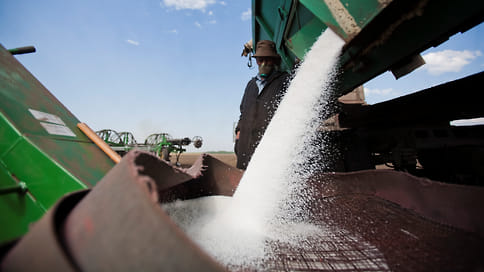Nitrogen for the future – Picture of the day
[ad_1]

A reduction in the production of nitrogen fertilizers in Europe against the background of high gas prices in 2022, as well as low prices for fertilizers in 2023, make the segment the most promising in terms of increasing production in Russia. Experts believe that decarbonization may increase demand for ammonia as an alternative to hydrocarbon fuel, and increasing production of small-scale chemicals in Russia will increase the need for methanol.
The volume of mineral fertilizer production in Russia in the next five years may increase to 70 million tons in physical weight, predicts the Russian Association of Fertilizer Manufacturers (RAPU). This is 18% higher than the figures for 2023, which became a record in the history of the national chemical sector. In 2024, while maintaining current capacity utilization, RAPU expects fertilizer production to increase by 10% compared to 2023, to 64 million tons. The restoration of investment programs after the decline in 2022 should in the near future ensure an increase in the total investments of Russian chemical companies to 2 trillion rubles.
According to experts, the nitrogen sector appears to be the most promising area for increasing production capacity. Nina Adamova, an analyst at the Center for Economic Forecasting at Gazprombank, explains this by saying that during the energy crisis of 2021–2022, due to high prices for raw materials—natural gas—a large amount of nitrogen fertilizer production capacity was lost in the world.
In 2022, after the start of a special operation in Ukraine, gas quotations in Europe set a historical record, approaching $3.9 thousand per 1 thousand cubic meters, and in subsequent months did not fall below $1 thousand per 1 thousand cubic meters, and after the beginning of active gas injection into underground storage facilities in August again exceeded $3 thousand per 1 thousand cubic meters. Against this background, by the fall of 2022, dozens of enterprises in Europe stopped or reduced their workload to a minimum, including the Norwegian Yara, the Lithuanian Achema and the Polish Grupa Azoty. Overall, nitrogen fertilizer production in the EU has fallen by more than a third due to unprofitability.
In 2023, companies were unable to significantly increase production due to falling prices for nitrogen products. Thus, by the end of the year, the cost of urea and methanol on various supply bases was about $300 per ton, ammonia – about $600 per ton, which is more than one and a half times lower than in December 2022. According to calculations by the consulting company Implementa, the spread between the price of gas and urea in Europe in 2023 has decreased by more than half compared to pre-crisis 2021 values, so the economic feasibility of urea production in the EU remains in question. Taking into account the decline in domestic production in Europe, CEP experts note a trend towards an increase in purchases of Russian nitrogen fertilizers with a decrease in Russian gas imports.
All major Russian companies intend to increase the production of nitrogen fertilizers. Thus, the Acron group at its site in Nizhny Novgorod plans to modernize four urea units, hoping as a result to increase their production output by one and a half times, to 1.1 million tons per year. The project cost is $80 million.
In 2024, EuroChem plans to complete the construction of a new production of nitrogen-potassium fertilizers in Nevinnomyssk, and also continues the construction of the EuroChem North-West-2 plant for the production of urea and ammonia with a capacity of 1.4 million tons of urea and 250 thousand tons of commercial ammonia .
Uralchem is preparing to launch an ammonia transshipment terminal in Taman in the second quarter of 2024. At the first stage, its capacity will be up to 2 million tons per year. The second stage of construction is planned for 2024–2025, with its commissioning the capacity will increase to 3.5 million tons of ammonia and 1.5 tons of urea per year. The commissioning of new port facilities will make it possible to restore ammonia production at Togliattiazot, a member of the group, which was actually stopped in 2022 due to the impossibility of further exporting products via the Togliatti-Odessa ammonia pipeline. The cost of construction of the terminal in Taman, according to recent estimates, is 60 billion rubles.
In the first half of 2024, Phosagro may make a final investment decision on the construction of new large nitrogen facilities at the site in Cherepovets. At the end of 2021, the company announced plans to build a complex in Cherepovets with a capacity of about 1 million tons of ammonia and up to 1 million tons of urea per year. The company expected to select a contractor in February 2022, but the tender was not completed. Phosagro is now at the stage of developing the final parameters of the complex and is negotiating the project with equipment licensors from China.
Dmitry Akishin from Implementa also considers nitrogen products promising, given the predictably low gas prices in Russia. According to him, moderate growth is observed in all segments of ammonia consumption in the world. The expert notes that there is great potential for using ammonia for decarbonization, including as a replacement for hydrocarbon-based motor fuels, but to realize this opportunity it is necessary to resolve a number of technological issues, including in the field of safety. He also sees opportunities for growth in demand for methanol in the domestic market of the Russian Federation against the backdrop of the development of small-scale chemicals.
According to Nina Adamova, in the coming years, global demand will slowly but steadily grow for all types of fertilizers. Therefore, the expert notes, investors will decide on the construction of new capacities based on specific efficiency criteria and the characteristics of individual projects. She recalls that Russian companies have large-scale plans to expand production of other types of fertilizers – phosphorus and potash.
[ad_2]
Source link





